Shoot the Video, Not Me
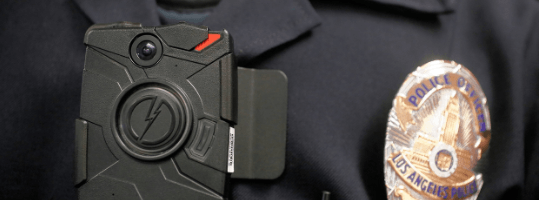
Social media spurred national outrage at the police killing of Mike Brown in 2014, which in turn sparked a movement mandating the police force to wear body cameras while on duty. Results have been mixed, but the jury is still out on how the digitization of police operations will change the culture of policing for years to come.
The Story.
Bang, bang. The black asphalt erupts into a red river marking a little sister’s protector, a younger brother’s biggest hero, and wondrous goals never to be fulfilled. The officer recoils. The passersby fill the lifeless air with chaotic screams. Some brave soul whips out a cellphone and documents everything on camera, saturating Facebook, Instagram and Twitter.
#FillNameHere.
We have heard this story before. The killing of unarmed civilians by armed officers is not new. However, the digitization of modern America has thrust these killings into the limelight, crystallized by the fatal shooting of Michael Brown in Ferguson, Missouri on August 9, 2014.
The Numbers.
As of January 2013, 477,000+ full-time police officers served in 12,326 U.S. agencies [1]. Only 32% of local departments, representing 24% of officers, provided officers with wearable body cameras [2]. When including in-car and weapon-attached video cameras, 32% increased to 76%.
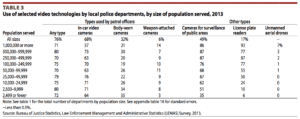
A Call for Change.
Four interminable hours, bloodied and uncovered for the world to see. I, like many of my peers, first heard the news about Mike Brown on Twitter. Mike was not the first, and he was not the last, but his death birthed the push to hold all police officers accountable to fulfill their oath to serve and protect all communities. Although law enforcement has long relied on intelligence analysis (computerized records, data analytics for predictive policing) and intelligence access (license plate readers, gunshot detection systems) technology for its daily operations, evidence-gathering arm technology (dash- and body cameras) is still underdeveloped [3]. Without video evidence of fatal interactions, ambiguity surrounding the rightful use of fatal force or not engulfs each new case of a civilian slain at the hands of an officer.
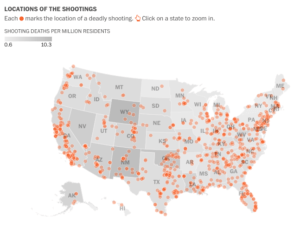
Source: https://www.washingtonpost.com/graphics/national/police-shootings-2016/
Digitizing the Evidence.
Digitizing policy activity aims to add transparency and accountability possible to police-civilian interactions, while also enhancing officer safety and reducing officer liability. In September 2015, the Department of Justice provided over $23.2 million to support 73 police departments in 68 major cities: $19.3 million for camera purchase, $2 million for training and maintenance, and $1.9 million for implementation impact studies [4]. However, impact studies are mixed.
A randomized controlled trial of 988 U.K. police officers revealed that use of body cameras results in 87.5% fewer reported incidents of force and 59% fewer civilian complaints [5]. However, a retrospective study of 2,652 U.S. police departments revealed a 3.64% increase in shooting-deaths with wearable body cameras (disproportionately higher for African-Americans and Hispanics), likely secondary to officers turning on their cameras more when they anticipated needing to use deadly force [6]. Performance Scorecard of 50 Departments [7].
Challenges for implementation.
Compliance with wearable cameras is a huge challenge in the police force, whether because officers do not “understand the policy to turn them [the cameras] on and things like that”[8] or because of resistance to full transparency. In July 2016, North Carolina signed House Bill 972 into law to require a court order prior to releasing any body camera footage recorded, allowing the police force to keep recordings “beyond the reach of the state’s public records law”[9]. As of August 2016, police departments in 24 major cities did not make their policies publicly available, and departments in 25 major cities had not actually implemented any policies for use of the cameras they purchased [10].
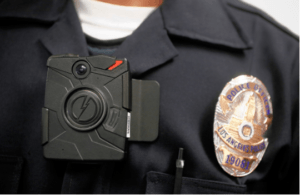
Additionally, upfront and maintenance costs of cameras are not insignificant. Taser (>$1 billion valuation, ‘14), Digital Ally ($38 million valuation, ‘14), VieVu, and Google are the four main camera manufacturers, which enjoyed spikes in sales following Mike Brown’s killing [11].
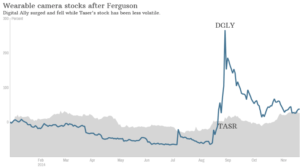
Of the 32% of agencies that have ever used cameras, many suspended their programs due to a mandate to store videos for at least 190 days. With this mandate, department costs for cameras (~ $1000 each), new servers, software and training in Clarksville, IN rose from $5,000-$10,000 a year (30-day storage) to $50,000-$100,000 [12]. In larger cities, the cloud-based high-volume storage facilities required for the tens of thousands of weekly video generated costs upwards of $1 million, with twice as much data required for 1080p resolution versus 720p [13].
The future.
In an attempt to deliver on its perceived value as protector of the law and the people, the police force has shifted its operations – albeit non-uniformly and incompletely – to incorporate wearable body cameras. To make this transition successful, all agencies granted federal funding for cameras should be forced to use them or else lose their funding. Since some officers lack the training to press record, manufacturers should make automatized cameras that turn on as soon as an officer steps out of his/her vehicle. Finally, more camera manufacturers need to enter the market to drive down purchase costs.
From social media to wearable body cameras, technology is a vehicle for social change. However slowly, that change is gonna come.
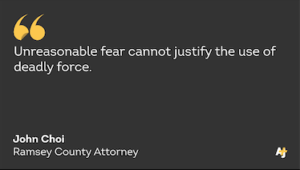
(794 words)
- Reaves, Brian. “Local police departments, 2013: Personnel, policies, and practices.” S. Department of Justice. May 2015. http://www.bjs.gov/content/pub/pdf/lpd13ppp.pdf
- Reaves, Brian. “Local police departments, 2013: Equipment and technology.” S. Department of Justice. July 2105. https://www.bjs.gov/content/pub/pdf/lpd13et.pdf
- Pang, Min-Seok and Paul Pavlou. “Armed with Technology: The impact on Fatal Shootings by the Police.” Fox School of Business, Temple University. September 8, 2016. https://papers.ssrn.com/sol3/papers.cfm?abstract_id
=2808662&download=yes
- S. Attorney’s Office. “Justice Department Awards over $23 Million in Funding for Worn Camera Pilot Program to Support Law Enforcement Agencies in 32 States.” Department of Justice. September 21, 2015. https://www.justice.gov/usao-edca/pr/justice-department-awards-over-23-million-funding-body-worn-camera-pilot-program
- Barak, A., Farrar W, Sutherland A. “The effect of police body-worn cameras on use of force and citizens’ complaints against the police: A randomized controlled trial.” (Sep 2015). Journal of Quantitiative Criminology. Vol 31:3. http://link.springer.com/article/10.1007%2Fs10940-014-9236-3
- Pang et al. [See 3].
- The Leadership Conference. “Police body worn cameras: A Policy scorecard.” Upturn. August 2016. https://www.bwcscorecard.org
- Sharp, John. “Why police body cameras are surfacing as a top concern for Mobile following officer shooting of Michael Moore.” com. June 22, 2016. http://www.al.com/news/mobile/index.ssf/2016/06/why_police_body_cameras_are_su.html
- Binker, Mark. “New NC body camera law will mean court order required for police video release.” com. September 22, 2016. http://www.wral.com/new-nc-body-camera-law-will-mean-court-order-required-for-police-video-release/16037830/
- The Leadership Conference. BWC Scorecard. [See 7].
- La Monica, P. “Investors try to profit from Ferguson.” com. Nov 24, 2014. http://money.cnn.com/2014/11/24/investing/digital-ally-ferguson/
- “Human Rights. “Two US police departments drop body cameras over costs.” com. 11 September 2016. http://www.aljazeera.com/news/2016/09/police-departments-drop-body-cameras-costs-160911075457471.html
- Kotowski, Jason. “Money, storage primary obstacles in police camera implementation.” Emergency Management. March 8. 2016. http://www.emergencymgmt.com/safety/Police-Body-Cam-Installation.html



Nelly, this is a very powerful posting. Thank you for writing it and for sharing your research and your thoughts, I learnt a lot from this! The current ‘normalcy’ of police violence, especially against minorities, in our country is unacceptable and whilst I would like to say that I am hard-pressed to find a person who disagrees with this, I think we all know that that is not the case. This article in the National Review highlights that when it writes, “the left-wing media has created and sustained the false impression that America has a crisis of police shootings”. (http://www.nationalreview.com/article/439426/police-shootings-media-created-fake-crisis).
Whilst I do not believe that technology solves this issue, as at its core, it is a human issue, I do think that technology can hope to improve it somewhat. The dissemination of body-cameras to police officers should be the force wide and should be a requirement to be worn and to be turned ON at all times – why not have it on as a police officer is on his beat as well? If he is driving too quickly, sitting in a parking lot and eating, etc. there is no better way to catch it then to have him hoisted by his own petard. Until the police force is required to have cameras, that are recording, with them at all times they are on their beat, and the station is required to release the footage, I fear that body cameras will not make the difference that we need in police brutality.
Another technological advance that I would like to see implemented is a twist on the current ‘smart guns’. At the moment, there are many companies that are working towards building out safety features that prevent guns from being fired unless biometric data of the owner can be found. (https://en.wikipedia.org/wiki/Smart_gun). Whilst this does help with potential mass shootings, this does not help to solve the issue of police brutality. It seems logical to me that there should be some kind of safety measure that can be put into a gun, entering a 5 digit code, etc. before it is able to be shot so that a police officer cannot shoot on site and has to think before an impulse reaction kicks in. An Israeli startup called, ‘Zore’ has created something a little bit like this. (http://www.geektime.com/2016/06/15/israeli-gun-safety-startup-zore-launches-a-smart-lock-to-keep-weapons-secure/). Whilst I do not think this would solve the issue, I have hope that this, and other technologies, might help to move us in the right direction as we wait for humanity to catch up.
What a great post, Nelly-Ange. I completely agree that video surveillance needs to play a role here. It actually blows my mind that this hasn’t already been adopted on a national scale. Resistance to full transparency seems like an antiquated excuse at this point.
My one concern when it comes to body-cams is that police officers will be able to pick and choose which encounters they record. If that’s the case, the videos will be entirely useless. I think it’s very important that these cameras are continuously recording and police officers have no ability to turn them on and off. I understand that this would be a double-edged sword because continuous recording may mean that rape victims get caught on camera and that brings up a slew of privacy issues. But, I firmly believe that in this case, the benefits outweigh the costs.
This is a really interesting deployment of technology. However, a large part of the digitization challenge is the ethics of bringing the digital into everyday life. Few people would argue that surveillance cameras on every street corner is a desirable use of technology – despite the fact that crime would likely decrease. As I see the police body-cam argument, we are inverting the “1984” world that was imagined at the advent of digitization. In 1984 the powers-that-be surveilled the disenfranchised under the auspices of crime reduction, and that dystopia was immediately recognizable. I think it is an interesting conversation to consider how the ethics change when it is instead the disenfranchised who surveill the powers-that-be under the auspice of abuse reduction.
Given the large cost of the investment I think the ethical conversation is an important one to have, but I’m glad you started the conversation here!